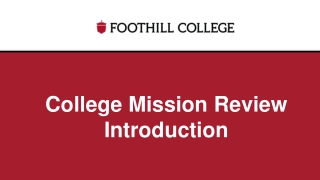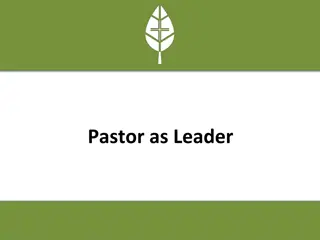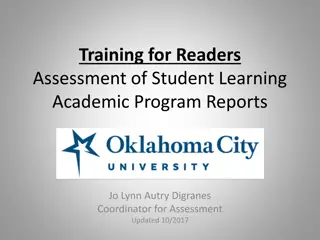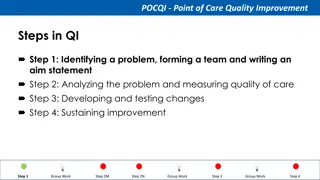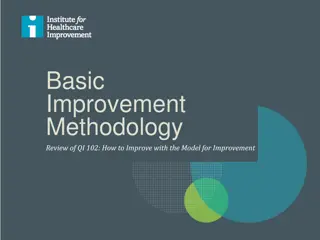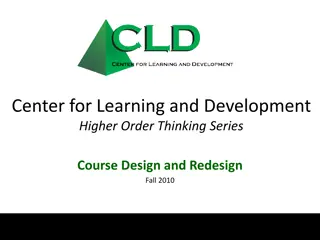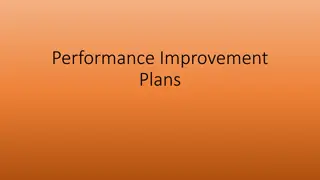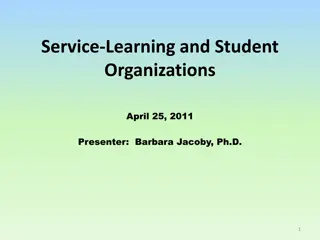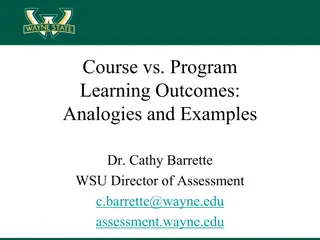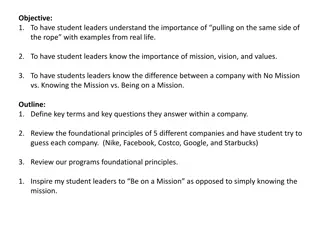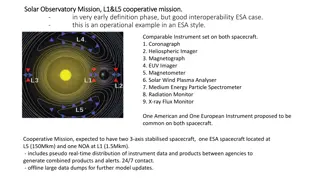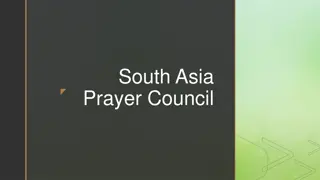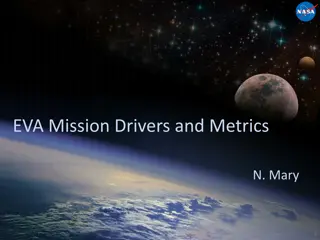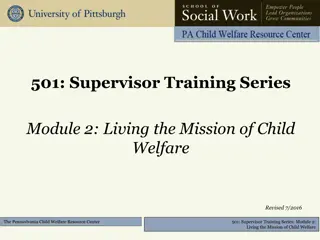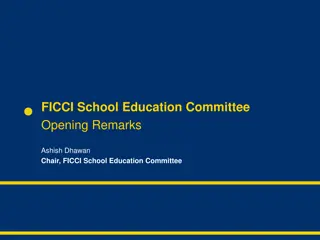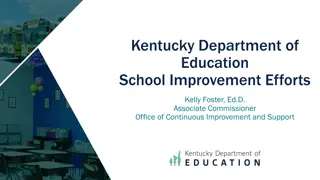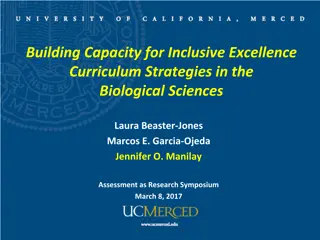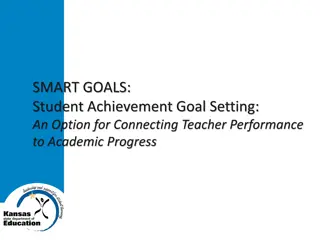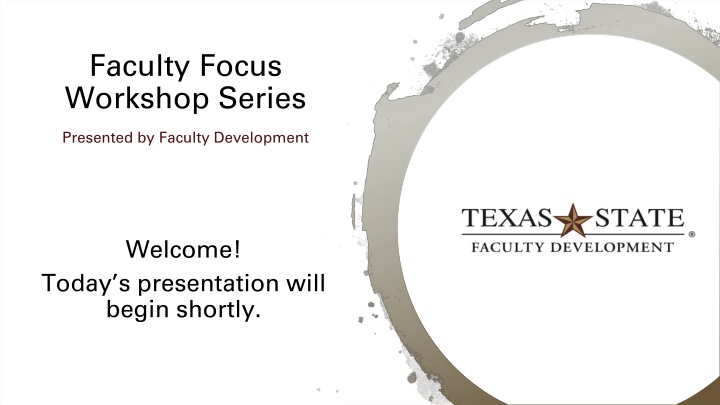
Developing Academic Program Outcomes and Assessment Methods
Explore the process of developing academic program outcomes, refining program missions, and assessing student learning in this faculty workshop series. Learn to identify appropriate outcomes, design assessment methods, and locate data sources for continuous improvement. Understand the significance of aligning with institutional effectiveness standards and expectations for reporting results and action plans.
Download Presentation

Please find below an Image/Link to download the presentation.
The content on the website is provided AS IS for your information and personal use only. It may not be sold, licensed, or shared on other websites without obtaining consent from the author. If you encounter any issues during the download, it is possible that the publisher has removed the file from their server.
You are allowed to download the files provided on this website for personal or commercial use, subject to the condition that they are used lawfully. All files are the property of their respective owners.
The content on the website is provided AS IS for your information and personal use only. It may not be sold, licensed, or shared on other websites without obtaining consent from the author.
E N D
Presentation Transcript
Faculty Focus Workshop Series Presented by Faculty Development Welcome! Today s presentation will begin shortly.
Developing Mission, Outcomes and Methods to Assess Student 1 Improvement Lon Olson, Ph.D. Director of Assessment lwo5@txstate.edu
Workshop Goals 2 To develop the knowledge and skills to: become more adept in the assessment of student learning outcomes and program administrative outcomes refine the mission of the academic program identify student learning outcomes and administrative outcomes appropriate to the mission of the program design appropriate methods to assess achievement of outcomes locate data sources to establish administrative outcomes, methods, and targets
SACSCOC Influence 3 Institutional Effectiveness Continuous Improvement 8.2 The institution identifies expected outcomes, assesses the extent to which it achieves these outcomes, and provides evidence of seeking improvement based on analysis of the results in the areas below: (Institutional Effectiveness) a. Student learning outcomes for each of its educational programs, (Student outcomes: educational programs) b. Student learning outcomes for collegiate-level general education competencies of its undergraduate degree programs, (Student outcomes: general education) c. Academic and student services that support student success. (Student outcomes: academic and student services
Expectations 4 In Fall - programs revisit Mission, Outcomes, and Method In Spring - programs report Results, Action Plans, and Evidence of Improvement
Mission Statement 5 A broad statement of what the program is, what it does, and for whom it does it A clear description of the purpose of the program and the learning environment Reflects how the program contributes to the education and careers of students graduating from the program Aligned with department, college, and university missions Distinctive for your program and the level of the program
Mission Statement Components 6 Primary functions or activities of the program most important functions, operations, outcomes, and/or offerings of your program Purpose of the program the primary reasons why you perform your major activities or operations Stakeholders groups or individuals that participate in the program and those that will benefit from the program
Mission Statement Example 7 Industrial Engineering The mission of the Industrial Engineering (IE) program is to provide an excellent and innovative education setting to our students so they can learn and discover how complex systems work better. The IE program strives to maintain a comprehensive curriculum that enables students to become leading engineers and/or creative researchers in the global marketplace and/or in graduate studies. The program seeks to collaborate with private and public sectors in the search of methodologies and creative solutions to problems that contribute to the advancement of education, technology, and professional development. Through plans and activities that search to embrace a student population of strong diversity, the program attempts to be a significant provider of global workforce.
Checklist for Mission Statement 8 Is it distinctive, specific to the program, and at the appropriate level? Does it clearly state the core purpose of the program? Does it indicate the primary function or activities of the program? Does it indicate who the stakeholders are? Does it clearly support the department s, college s, and university s missions? Is it appropriate for the level of the program? Is the statement brief and memorable?
Outcomes 9 Aligned to mission and goal statements Clearly describe and define expected abilities, knowledge, values, and attitudes of the graduates of the program Simply stated Important to the mission and level of the program Stated so that a single method can be used to measure the outcome Written so that more than one measurement method can be used Focus on the learning or administrative results and not the process Measurable and there are resources available Can be used to identify areas to improve
Outcome Requirements 10 Undergraduate Academic Programs Five student learning outcomes and two administrative outcomes Graduate Academic Programs Three student learning outcomes and two administrative outcomes Certificate Programs Three student learning outcomes General Education Courses Four to five student learning outcomes identified by the General Education Council
Student Learning Outcomes 11 Describe specific knowledge and skills that a student of your program should demonstrate after completing the program Focus on the intended abilities, knowledge, values, and attitudes of the student after completion of the program What is expected from a graduate of the program? What is expected as the student progresses through the program? three questions What does the student know? (cognitive) What can the student do? (psychomotor) What does the student care about? (affective)
Student Learning Outcomes Examples 12 Do not try to insert too many skills into one learning outcome: -Students will identify, analyze, write, and apply the fundamentals of . Avoid writing outcomes that span 100 level and 400 level skills all in one outcome.
Student Learning Outcomes Examples 13 Studio Art The students will demonstrate the ability to professionally present visual artwork in methods appropriate to the work such as framing, hanging, and installation. Geography Students will demonstrate knowledge of quantitative methods used by geographers and their ability to use statistical software to solve geographic problems.
Blooms Cognitive Taxonomy 14 Bloom s Taxonomy can be an aid when drafting your outcomes The verbs should be tied to the level of the skill being assessed Introductory courses tend to rely on verbs such as identify, list, recall, explain. More advanced outcomes should focus on verbs such as analyze, create, design, synthesize, integrate etc. The type of verb you use to write your outcome will tend to drive the type of assessment method that you use to assess that outcome.
Administrative Outcomes 15 Reflect the expectations for the program Describe what you hope to accomplish Focus on the intended end results i.e., change in productivity, student success, participation, resource usage, delivery
Administrative Outcomes Examples 16 Studio Arts The Studio Arts program will realize gains in student success. Geography The Geography program will realize efficiency in the delivery and completion of the program.
Checklist for Outcomes 17 Are the outcomes aligned with the mission, vision, values, and goals? Do outcomes focus on issues important to the level of the program? Do outcomes reflect learning through the (required) program curriculum? Is it possible to collect accurate and reliable data for each outcome? Do outcomes describe the knowledge abilities, values, and/or attitudes students graduating from the program are expected to demonstrate? Are they stated so that it is possible to use a single method to assess the outcome? Are they stated so that more than one assessment method can be used? Can they be used to identify areas to improve? Are they stated in clear and precise language?
Methods and Measures 18 Should provide an objective means of measuring the extent to which students achieve the outcome and the efficiency or productivity of course and related activities Provide multiple (at least two) ways to measure each outcome Should indicate how and when you will assess each outcome Preferably should be indicated through direct methods Indicate a preferred target of attainment
Method Descriptions 19 What are you going to use? presentation, assignment, test, survey, observation, performance rating Of and/or by whom? Student, supervisor, focus group Context (e.g., where or when)? mid-semester, end of program For what purpose? desired learning outcome To what extent? hard targets, year to date attainment, or comparison to other programs in department, school, or college example:Test (essay) the students at the midpoint of the course for their level of knowledge in XYZ. Students are expected to score 85 percent or higher.
Methods Example student learning 20 Studio Art Outcome The students will demonstrate the ability to professionally present visual artwork in methods appropriate to the work such as framing, hanging, and installation. Method All work submitted by our graduating seniors for the Thesis Exhibition will be evaluated by faculty with specific subject-area expertise. A rubric using the ratings of "exceeds, meets or fails" will be used by each faculty member in the review of their students work. The rubric is coded and the coded sub-categories related to this outcome will be reviewed. Eighty percent of the students will "meet" or "exceed" expectations using the applicable sections of the rubric.
Creative Thinking Value Rubric-AAC 21 Capstone Milestones Benchmark 4 3 2 1 Acquiring Competencies Reflect: Evaluates creative process and product using domain-appropriate criteria. Create: Creates an entirely new object, solution or idea that is appropriate to the domain. Adapt: Successfully adapts an appropriate exemplar to his/her own specifications. Model: Successfully reproduces an appropriate exemplar. This step refers to acquiring strategies and skills within a particular domain. Taking Risks Actively seeks out and follows through on untested and potentially risky directions or approaches to the assignment in the final product. Incorporates new directions or approaches to the assignment in the final product. Considers new directions or approaches without going beyond the guidelines of the assignment. Stays strictly within the guidelines of the assignment. May include personal risk (fear of embarrassment or rejection) or risk of failure in successfully completing assignment, i.e. going beyond original parameters of assignment, introducing new materials and forms, tackling controversial topics, advocating unpopular ideas or solutions. Solving Problems Not only develops a logical, consistent plan to solve problem, but recognizes consequences of solution and can articulate reason for choosing solution. Having selected from among alternatives, develops a logical, consistent plan to solve the problem. Considers and rejects less acceptable approaches to solving problem. Only a single approach is considered and is used to solve the problem. Embracing Contradictions Integrates alternate, divergent, or contradictory perspectives or ideas fully. Incorporates alternate, divergent, or contradictory perspectives or ideas in a exploratory way. Includes (recognizes the value of) alternate, divergent, or contradictory perspectives or ideas in a small way. Acknowledges (mentions in passing) alternate, divergent, or contradictory perspectives or ideas. Reformulates a collection of available ideas. Innovative Thinking Extends a novel or unique idea, question, format, or product to create new knowledge or knowledge that crosses boundaries. Creates a novel or unique idea, question, format, or product. Experiments with creating a novel or unique idea, question, format, or product. Novelty or uniqueness (of idea, claim, question, form, etc.) Connecting, Synthesizing, Transforming Connects ideas or solutions in novel ways. Transforms ideas or solutions into entirely new forms. Synthesizes ideas or solutions into a coherent whole. Recognizes existing connections among ideas or solutions.
Methods Example student learning 22 Geography Outcome Students will demonstrate knowledge of quantitative methods used by geographers and their ability to use statistical software to solve geographic problems. Method Students will be evaluated during the semester by instructors on their knowledge of quantitative methods using 10 embedded test questions from the course: Quantitative Methods for Geography (GEO 3301). Students will be expected to answer 8 of the 10 questions correctly.
Methods Example - administrative 23 Studio Arts The Studio Arts program will realize gains in student success. Method Student retention success in the Studio Arts program will be measured by observing one year retention rates of students enrolled in the academic program from their freshman to sophomore year. Data will be obtained from the university s certified enrollment records at the end of the fall semester. Rates of retention success will be expected to be at or above 85 percent.
Methods Example - administrative 24 Geography Outcome The Geography program will realize efficiency in the delivery and completion of the program. Method Completion efficiency will be measured by observing the average time-to- completion for students in the undergraduate academic program. Data will be obtained from the university s certified enrollment records for the fall semester. The time-to-completion of graduates is expected to be at or below 4.0 years for the completion of the undergraduate program.
Data for Administrative Outcomes 25 Data may be obtained from Institutional Research CatStats (only available from on-campus) https://catstats.txstate.edu/ Self-Service Tools on the Institutional Research Website http://www.ir.txstate.edu/ir-self-service/self-service Contact Institutional Research JCK 883 512-245-2386 ir@txstate.edu
Checklist on Methods 26 Does the method describe who, how when, where and what will be assessed? Is assessment derived from required components of the curriculum? Have clear performance targets been identified? Are the data reasonably easy to collect or access within the year? Does the method build on existing data? Are students motivated? Is the information directly controllable by the program? Can subcomponents of a measurement be identified to allow deeper analysis? Does method focus on direct measures?
Overall Considerations 27 Is the plan written in terms that are understandable to someone outside of the field or institution? Are outcomes, methods, and targets stated simply, consistently and clearly? Do learning outcomes focus on learning rather than grades, attendance, participation or other activities? Is there a link between the mission, outcomes, and methods? How will findings be reported? Is there enough information in the methods to clearly analyze and report results? Do results need to be disaggregated for mode or location of delivery? Will you be able to develop an action plan if results don t meet the target?
Outcomes Assessment Resources 28 Outcomes Assessment Website with Process Information http://www.avpie.txstate.edu/assessment/outcomes-assessment.html Outcomes Assessment Data Repository for Entering or Reviewing Reports https://tim.txstate.edu/sacsoutcomes/ CatStats (only available from on-campus) https://catstats.txstate.edu/ Self-Service Tools on the Institutional Research Website http://www.ir.txstate.edu/ir-self-service/self-service
Contacts 29 Lon Olson, Director of Assessment 1016 JCKellam 512-245-8114 lwo5@txstate.edu Ismael Lozano, Administrative Assistant, Institutional Research 883 JCKellam 512-245-2386 gt05@txstate.edu

